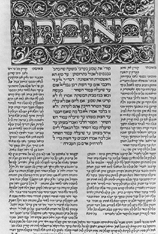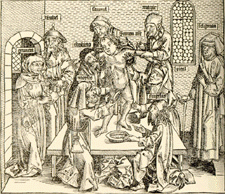
 |
Jews have existed since very ancient times. By 1000 B.C.E. they founded a national state, Israel, and practiced a distinctive religion, Judaism. This nation was conquered several times and was eventually absorbed into the Roman Empire. Despite their religious differences, in Roman times Jews were legally citizens of the Empire. Christianity began as a sect of Judaism-- but their paths diverged very quickly. Jews rejected the idea of Jesus' messianic divinity, a belief antithetical to the fundamental basis of Christianity. Following the second Jewish revolt against Rome, in 135 C.E., the Jews were driven out of Jerusalem and thereafter lived throughout the Roman Empire and later the emerging medieval states. In 600 C.E., the completion of the Talmud provided a basis for a reorganization of Jewish life according to Rabbinic precepts.
Jews differed from Christian norms with respect to the creation of the Talmud and the rejection of Christian beliefs, and were therefore marginalized by being "apart from the norm." Despite their marginalization, Jewish communities continued to define themselves as separate. They lived in their own communities, worshipped in their own tradition, and followed specific laws. They were, nonetheless, subject to laws created and enforced by Christians.
Persecution of Jews
 |
Throughout the Middle Ages the Jews became increasingly marginalized because of political and economic disadvantages. For example, in Roman times Jews were citizens, but in the later Middle Ages they were treated under the law as resident foreigners. They lived under the protection of the King, yet this also meant that they were vulnerable to his whims. Jews were also unable to own Christian slaves, or take Christian oaths, thus excluding them from the feudal and manorial systems. Thus, the only occupations available to them were those of artisans, traders, or money lenders.
Persecution of Jewish communities began with the massacres in the Rhineland by Crusaders. In the twelfth century, the increasing centralization of states allowed for the existence of more uniform law, and urbanization expanded the role of money in society. The rise of guilds excluded Jewish artisans. These changes meant that Jewish traders and money lenders began to hold more important positions in society. And it was at this time--when Jews' religious differences were compounded with growing social and economic influence-- that they began to be seriously persecuted.
In the twelfth century, Jews were accused of murdering Christian children in order to make matzoh for Passover. Although the Church denounced this libel, in 1204 the papacy required Jews to segregate themselves from Christians and to wear distinctive clothing. It was alleged that the Talmud contained material offensive to Christians, and many Talmuds were publically burned. In the fourteenth century, Jews were accused of causing the Black Plague by poisoning wells. Jewish communities were expelled from England, France, and, finally, Spain.
Issues in the Study of Medieval Jews
Studying Jewish life in the Middle Ages entails the study of the history of Jewish culture as well as Christian culture. Jews and Christians managed to live together for many centuries before the Jews were persecuted ruthlessly. The persecution of this minority group occurred when Christian and secular identities became more defined. Jews were perceived as having power over the Christians that Christians believed they should not possess. Therefore, when studying Jewish medieval culture, one needs to take into account both Jewish and Christian documents.
Jewish Self-Definition
 |
Throughout the Middle Ages Jews constituted their own communities. A strong sense of self-identification enabled Jewish survival despite repeated persecution and expulsions. Some factors important in Jewish self-definition include the following:
 |
Jewish Documents
Christian Documents